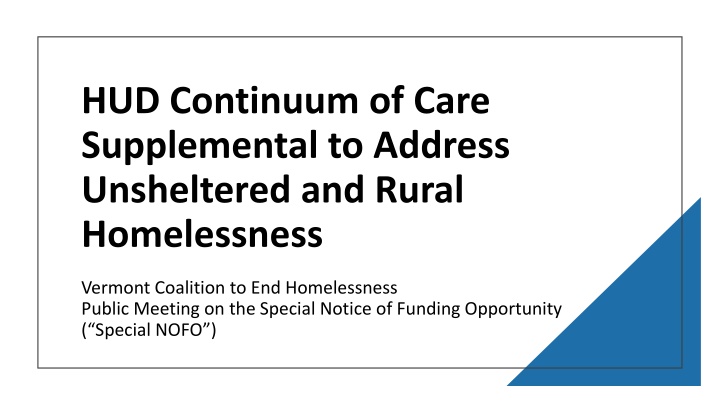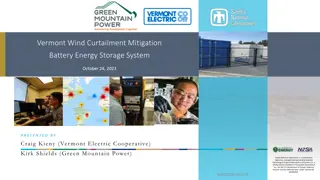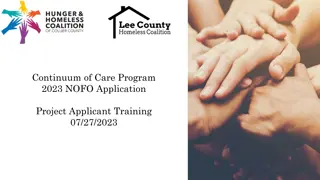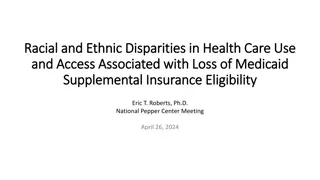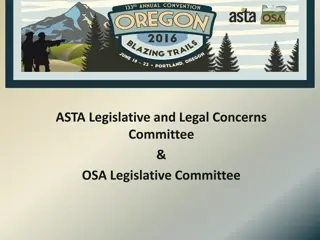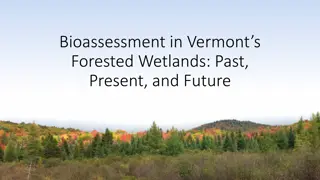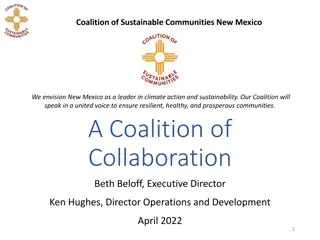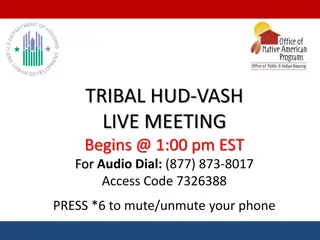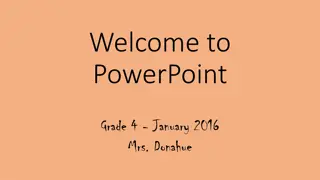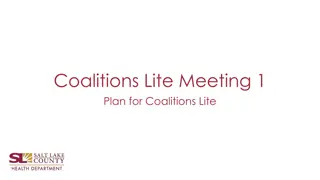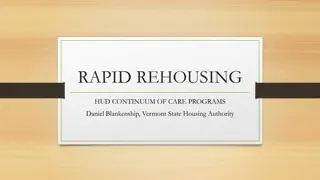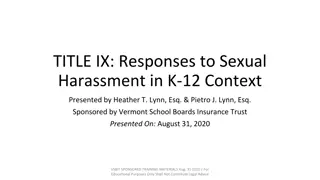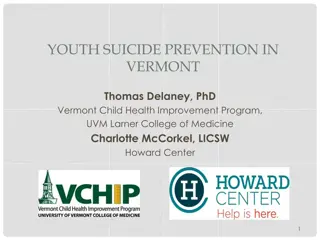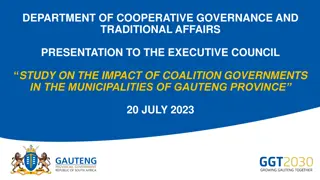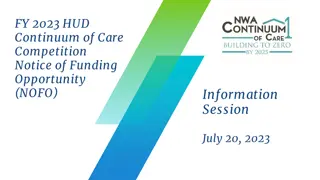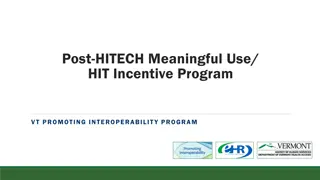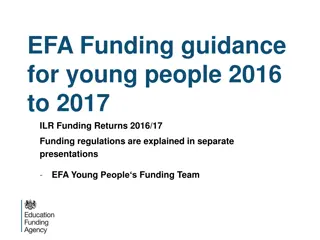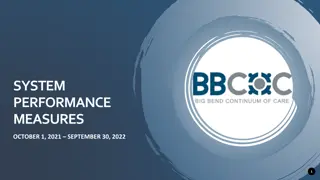HUD Continuum of Care Supplemental Funding for Vermont Coalition Public Meeting
HUD Continuum of Care Supplemental Funding aims to address unsheltered and rural homelessness in Vermont. The funding opportunity focuses on providing support for various project types including Permanent Supportive Housing and Rapid Re-housing. Program priorities include preventing unsheltered homelessness, addressing service needs in rural areas, and advancing equity. Projects will be selected based on specific criteria such as overall CoC application score and serving disadvantaged areas.
Download Presentation

Please find below an Image/Link to download the presentation.
The content on the website is provided AS IS for your information and personal use only. It may not be sold, licensed, or shared on other websites without obtaining consent from the author.If you encounter any issues during the download, it is possible that the publisher has removed the file from their server.
You are allowed to download the files provided on this website for personal or commercial use, subject to the condition that they are used lawfully. All files are the property of their respective owners.
The content on the website is provided AS IS for your information and personal use only. It may not be sold, licensed, or shared on other websites without obtaining consent from the author.
E N D
Presentation Transcript
HUD Continuum of Care Supplemental to Address Unsheltered and Rural Homelessness Vermont Coalition to End Homelessness Public Meeting on the Special Notice of Funding Opportunity ( Special NOFO )
Resources US Department of Housing & Urban Development https://www.hud.gov/program_offices/comm_planning/coc/specialCoCNOFO National Alliance to End Homelessness https://endhomelessness.org/event/understanding-the-special-nofo-to- address-unsheltered-and-rural-homelessness/ Vermont Coalition to End Homelessness https://helpingtohousevt.org/special-nofo-to-address-unsheltered-and-rural- homelessness/
Rural Set Aside $2,901,822 available to serve one or more counties in Vermont: All Counties except Chittenden and Franklin Application submitted by the Balance of State CoC Collaborative Applicant: Vermont Coalition to End Homelessness VCEH application will inclue one or more project applications and a priority listing of projects. Projects are reviewed and ranked by the Ranking Committee Grant term: 3 years, with potential for renewal
Program Priorities 1) Preventing and Addressing Unsheltered Homelessness 2) Addressing Severe Service Needs in Rural Areas 3) Assistance on Tribal Lands 4) Involving a Broad Array of Stakeholders in the CoC s efforts 5) Advancing Equity 6) Use a Housing First Approach
Permanent Housing Permanent Supportive Housing (PSH) Rapid Re-housing (RRH) HUD Special NOFO Eligible Project Types Joint Transitional Housing and Rapid Re-housing (TH-RRH) Supportive Services Only (SSO) Coordinated Entry (SSO-CE) Street Outreach (SSO-SO) Standalone Services HMIS
Project Selection HUD will select projects for funding based on a formula that includes: Overall score of the CoC Consolidated Application CoC ranking of the project Serving structurally disadvantaged areas Geographic areas that have high levels of homelessness, housing distress or poverty, and are located where CoC services have until now been entirely unavailable.
CoC Consolidated Application (89 pts) Project Capacity, Review and Ranking System Performance CoC Coordination and Engagement CoC Plan for Serving Individuals and Families Experiencing Homelessness with Severe Service Needs (59 points)
Letters of Interest (not required): Friday, August 19th Special Meeting for potential project applicants (not required): Monday, August 22nd Special NOFO Public Meeting: Monday, August 29th Important Dates Draft Plan to Serve Individuals and Families with Severe Service Needs: Friday, September 9th Request for Proposals & Project Application Form: Friday, September 9th Project Applications due to VCEH: September 20, 2022
Plan to Serve Individuals and Families with Severe Service Needs DRAFT PROPOSAL FOR REVIEW DRAFT PROPOSAL FOR REVIEW
Severe Severe Service Service Needs Needs
Severe Severe Service Service Needs Needs https://helpingtohousevt.org/wp- content/uploads/2022/04/VCEH- Housing-Assessment-12.2021.pdf
Leveraging Housing 18 Possible Pts Most points for: Increasing the # of permanent housing units for people experiencing homelessness Supplementing assistance with other housing resources Landlord engagement and incentives Specific MOUs/Letters of Commitment for Permanent Housing Projects with #/% of units using housing subsidizes or subsidized housing units Commitment from Public Housing Authorities
Leveraging Housing Plan Highlights Examples of Commitment: 15% Executive Order, PHA Move-on Preferences Examples of Effective Partnerships: A Way Home (VSHA CoC PSH Project), CARES Housing Voucher Program, Emergency Housing Vouchers, Landlord Liaisons (HOP, ERAP-HSS, YHDP) Newly constructed units with VHCB funds, use of Coordinated Entry (CE) and use of project-based vouchers Vermont Housing Improvement Program, commitment to use CE VHFA LIHTC 9% commitment to use CE VSHA and other PHA Commitments to partner on use of new Housing Stability Vouchers (if awarded)
Leveraging Housing Ranking Tool Ideas PSH, RRH and TH-RRH Projects require an MOU/Letter of Commitment to leverage new subsidized units or subsidizes Points for those not funded by CoC, ESG, HCV, HOME-ARPA or HOPWA Increased Points based on higher % of units in project (10-24%, 25-49%, 50+%) Points for specifically leveraging VHIP or VHCB units For RRH and TH-RRH Projects, points for commitment from PHA for a move-on preference
Leveraging Housing Ranking Tool Ideas For SSO projects, points If project will conduct CE Assessment with participants for one or more letters of support from permanent housing providers If project will provide flexible and all-encompassing services from unsheltered to temporary housing to permanent housing Pts for projects with specific landlord recruitment/engagements strategies (e.g., landlord liaison)
Leveraging Health Care Resources (10 pts) Permanent Housing projects that use health care resources Medicaid or insurance billing Leveraged resources TAILORED to the project (e.g, Free Clinic, FHQC, VDH) Partnerships with organizations providing services (e.g, Community Mental Health Agencies, HUBs for SUD) Project Eligibility not restricted by eligibility of Health Care services If SUD services, available to all participants All Services must be voluntary Up to 50% of total project budget
Leveraging Health Care Plan Highlights Vermont s use of Medicaid: AHS s waiver plan for approved for new PSH benefit Family Supportive Housing DMH Pathways Housing First Examples of Vermont housing/homeless + health care resources/partnerships: Vermont Chronic Care Initiative Homeless Health Care Capacity Building Project (VDH) HOPWA DMH Subsidy + CARE SASH Other highlights: Hub & Spoke SUD Treatment system
Leveraging Health Care Ranking Tool Ideas All projects encouraged to Health Care Services committed to project with an MOU/Letters of Commitment Points based on the value of health care services compared to budget request (most points if at least 50% of budget request) Points where SUD treatment/recovery services are leveraged and available to all project participants Points if project eligibility is not restricted by health care service provider (for example, not limited to CRT-eligible participants only, or not limited only to households receiving SUD services from local HUB)
Strategy to Identify, Shelter, & House People Experiencing Unsheltered Homelessness Possible 6 points Strategies regularly engage people experiencing unsheltered homelessness in locations they reside Street outreach is coordinated, targets the most vulnerable, connects people to permanent housing, uses peer-based services, is frequent, and uses data and best practices Strategies connect unsheltered with low barrier shelter options, temporary housing or permanent housing Housing First principles (vs. housing ready) Low barrier and culturally appropriate access to permanent housing Highlight any new practices in the past three years Connects to leveraged housing resources
Strategy to Identify, Shelter, & House People Experiencing Unsheltered Homelessness Plan Highlights Highlight path and other DMH-supported outreach services Use data from Coordinated Entry to highlight the number of unsheltered households currently reached; use PIT data to highlight pockets of unsheltered homelessness and demonstrate impact of expanded GA Emergency Housing and THP Vermont examples: Rapid Resolution Housing Initiative, CARES Housing Project, Emergency Housing Vouchers, Expansion of CE MOUs with housing developers, YHDP TH-RRH project performance, current VCEH CE PSH prioritizes unsheltered first
Strategy to Identify, Shelter, & House People Experiencing Unsheltered Homelessness Ranking Tool Ideas SSO projects which focus on outreach services to reach households experiencing homelessness where they reside PSH, RRH and TH-RRH Projects include strategies and partnerships with homeless outreach partners/projects Coordination with partners to reach and serve unsheltered households: First responders, faith-based organizations, emergency departments, other community organizations Specific strategies and partnerships to lower barriers to shelter (for SSO projects) and/or permanent housing (all projects), specifically: Allows pets, uses harm reduction strategies, no ID required for shelter, help to obtain ID documents quickly, does not screen out those with criminal background (unless federal restriction)
Identify & Prioritize Households Experiencing or With Histories of Unsheltered Homelessness - Possible 12 points Comprehensive approach to provide street outreach services to reach those who are unsheltered &/or have histories of unsheltered homelessness and prioritize for permanent housing CoC CE prioritization will contribute to reducing unsheltered homelessness Projects will reduce unsheltered homelessness Outreach services will connect people with housing resources Steps to improve ACCESS to housing, such as identification, housing navigation services and access to health care and supportive services.
Identify & Prioritize Households Experiencing or With Histories of Unsheltered Homelessness Plan Highlights Special NOFO Projects (PSH, RRH and TH-RRH) will prioritize Unsheltered Households (by Complex Service Need Score) and the Households with past experience of unsheltered homelessness (by Score) (for PSH, this is instead of chronic homelessness prioritization) Coordinated Entry Housing Assessment will ask about past experiences of unsheltered homelessness Data analysis of unsheltered homelessness in Vermont
Identify & Prioritize Households Experiencing or With Histories of Unsheltered Homelessness Ranking Tool Ideas Based on target population/geography, project will serve those who are unsheltered and/or have history of unsheltered homelessness
Involving Individuals with Lived Experience of Homelessness in Decision Making Possible 5 points People who have experienced homelessness particularly unsheltered homelessness are meaningfully and intentionally integrated into the CoC decision making structure. People with lived experience of unsheltered homelessness are involved in the delivery of services (e.g., hiring people with lived experience) Working Group of People with lived experience of homelessness meaningful outreach and engagement efforts Letter of support for the application
Involving Individuals with Lived Experience of Homelessness in Decision Making Plan Highlights Working group description and letter Examples of meaningful ways people with lived experience are involved in organizations and VCEH
Involving Individuals with Lived Experience of Homelessness in Decision Making Ranking Tool Ideas Projects involve people with lived experience of unsheltered homelessness in the delivery of services Projects plan to hire and support people who have experienced unsheltered homelessness or those who have fled DV/SV Applicant board of directors includes 2+ people with lived experience of homelessness
Supporting Underserved Communities & Equitable Community Development Possible 8 points How we to identify populations that have not been served by the homeless system at the same rate they are experiencing homelessness Describe how underserved communities in the geographic area interact with the homeless system, including a description of those populations Current strategy to provide outreach, engagement and housing interventions to serve overrepresented populations Serving structurally disadvantaged areas: high levels of homelessness, housing distress or poverty AND located where CoC services have been entirely unavailable
Supporting Underserved Communities & Equitable Community Development Plan Highlights Equity analysis as part of CE Annual Evaluation Health Equity Partnerships Challenges with rural data (small numbers) Identifying communities which have lost CoC services in recent years Data from PIT and CE on populations experiencing homelessness Identify Structurally Disadvantaged Areas
Supporting Underserved Communities & Equitable Community Development Ranking Tool Ideas Points for projects located in/will target structurally disadvantaged areas, and can describe how it has not been served Agency &/or Board leadership includes BIPOC members Agency &/or Board leadership includes LGBTQIA+ members Applicant will use HMIS data and disaggregate project data by race, ethnicity, gender identify and/or age
Structurally Disadvantaged Areas INSERT MAP HERE
General Ideas Encourage applicants without past CoC funding, but use ranking tool to prioritize those with administrative capacity and past experience with similar scope and funding? SSO, PSH, RRH and TH-RRH Projects only, HMIS is not a priority for Special NOFO funding? How can we ensure projects are coordinated with the local homeless coalitions? Projects coordinate and integrate other social services and employment programs? Weight areas the same as HUD will weight them in their review of the Plan?
